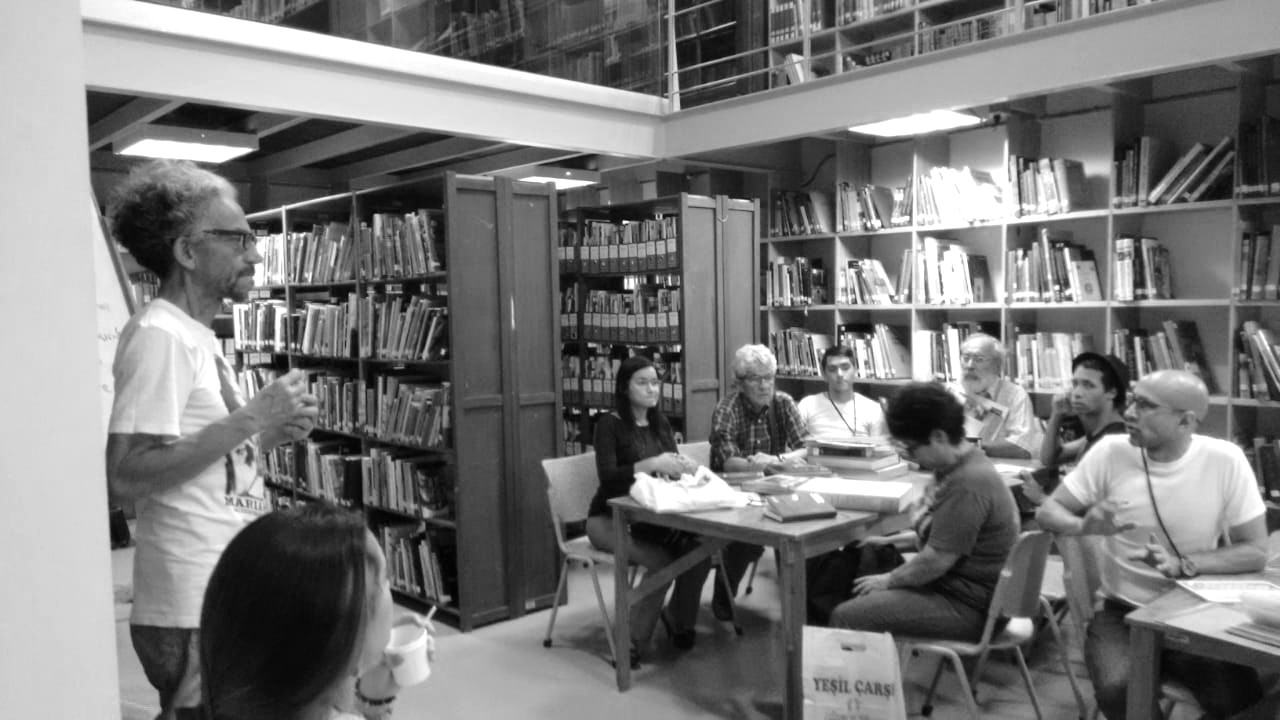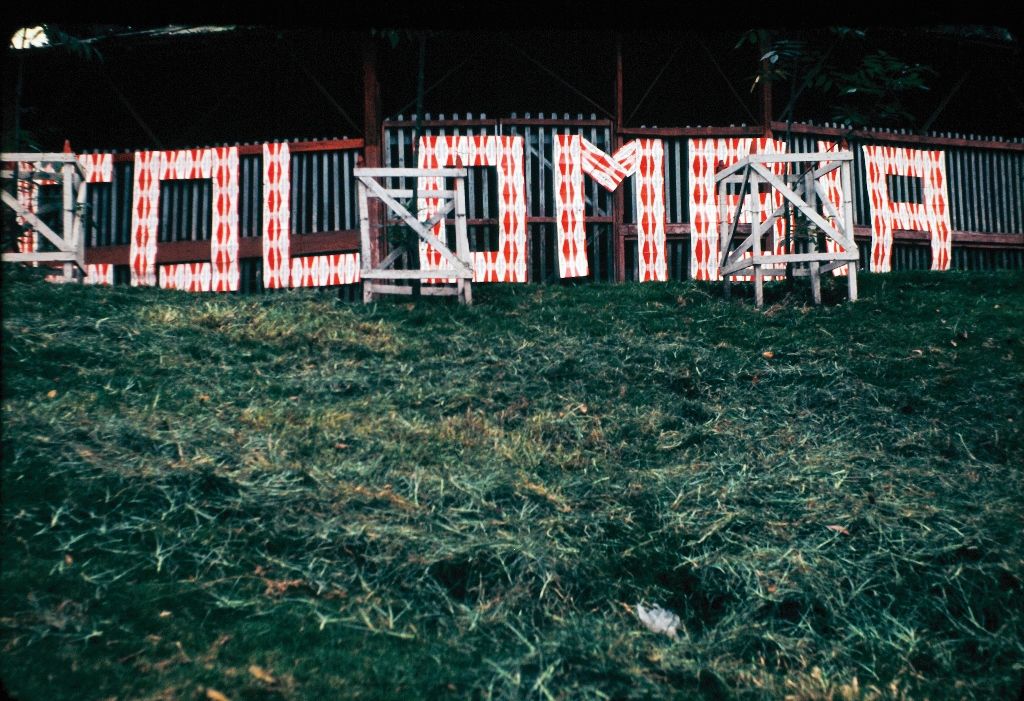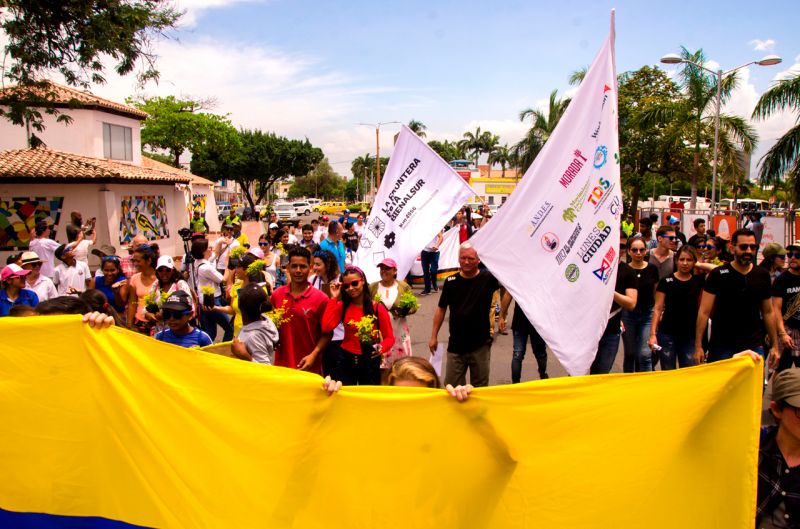La Escuela___: When reviewing Colombian art of the late twentieth century, we notice the presence of historical, political, and social themes in the work of many creators contemporary to Antonio Caro, however, his stands out remarkably from a particular space and language. What makes Antonio Caro's work a milestone in Colombian art history and a popular symbol in Colombia?
Where there Are Problems, there Are No Borders
04/15/2022
with Alex Brahim
Antonio Caro (Bogotá, Colombia, 1950 — 2021) was a conceptual artist known both for the forcefulness of his images as for his sharp and insightful personality. Characterized by the use and appropriation of popular icons and the repetition of simple messages, his work transcends themes of national idiosyncrasy to become a key to conceptualism in Latin America.
On this occasion, La Escuela___ reflects on his lessons along with curator, researcher, and director of the El Pilar Foundation, Alex Brahim who, from Cúcuta, Colombia, shares his experiences with Caro in the Visual Creativity Workshops, his pending projects for Juntos Aparte, and the complexities of developing a contemporary art initiative in a border characterized by precariousness and transitoriness.

Alex Brahim: Caro understood the proliferation and the life of his works beyond the confines of the controllable, a process of dynamization and communication ‘not dissociated from’ but not strictly ‘linked to’ the construction of a single-signature common heritage. In turn, he took up as a natural challenge the impossibility of a unique work of art, a work that does not have problems with its autonomous reproduction, without copyrights. With this, he also achieved a very powerful thing: that although many people recognize Colombia/Coca-Cola (1976) as a work of art, he also consolidated a public image from the appreciation of society, anchored to a national imagery. It was a move that went very well for Caro, which he could not have foreseen or quite calculated, beyond being true to what he understood was an artist's purpose as a social being today.

This sense of appropriation can be linked to the supports that his works assumed: posters, pamphlets, signs in which the word becomes an art 'object.' But what makes Antonio Caro's messages so unique and subversive? What makes his images a work of such forcefulness?
I believe that one very simple image can open up a universe of memories and possible interpretations, and that is precisely Caro’s legacy, and it is also the meaning of contemporary art as a space of pedagogy and learning. It is ultimately a question of empowering the citizens: providing elements of judgment with which to hold reasonable discussions about the things that affect us as a collective. Antonio had a very clear and sharp vision of the phenomena of reality, as well as an exceptional synthesis capacity to resolve in phrases and in very short sentences great complexities.
Does any particular occasion stand out?
For example, in 2019, when the second part of the La Gran Colombia trilogy was developed, he said a very specific phrase for an activity that we had. It was a massive citizen appropriation in favor of integration and in frontal rejection of aporophobia and xenophobia, from an awareness of the severe and deep crisis that crossed us all, beyond migration. The answer also had to start from a common recognition, so in the face of this situation, Caro said: "Where there are problems, there are no borders." It is too simple a sentence, too elementary, but with it, he managed to captivate and get the message through to every interlocutor who crossed paths with it along the metropolitan area of this border for a month. This was his great ability to take art out of the artistic sphere and understand it as a more ductal vector than its own establishment, oriented towards a space of contribution to the social reality. This is one of the key points for understanding the Antonio Caro phenomenon.
Let's talk about other keys to this phenomenon: The criticism implied in his work points in many cases towards issues of universal value such as globalization, consumption, and history. Do you consider this signaling a form of conscience?
Undoubtedly. Caro's sensibility was critical, there was no other way of seeing the world in him. In his work, the accusations are incisive, scathing and still very clear, so it is not surprising that many of them have become of public domain. His issues are mostly concerns, one can make out in them Caro’s ability to glimpse into the destinies of nations like Colombia and its relationship with the projections for the future that the world order offered several decades ago. These visionary reflections are precisely the origin of the graphic syntheses that transcended time and geography. This capacity to establish a direct and genuine dialogue between the local and what is frankly universal is rooted in this, with globalization and a hyperconnected society as the gear that allows it to spread and propel itself. This is where his pedagogical abilities do the leverage work, as a platform for expanding and encouraging critical consciousness.
Antonio Caro's reflexive processes stand out for their intellectual witticism and the humor of an incisive observer. In his Visual Creativity Workshops, under the premise that "we are all creative", Caro encouraged critical thinking and reflection in its participants. Do you remember the dynamics of his workshops?
I had the opportunity to be an assistant, a participant, and an organizer of his workshops. One of the aspects that I recall the most is Antonio’s consideration for the other as an interlocutor and as a subject of enunciation, and for the context at which he arrives, which modulates or conditions the development of each session. He had very clear, concrete, and non-negotiable guidelines regarding discipline: there was an assignment every day and you had to arrive with your homework completed. The assignment was done on a photocopy and everyone had to arrive with the same photocopy. This guaranteed equity in the type of product presented and it was the creative capacity that prevailed when assessing the proposal.
Was there a difference between Caro the artist and Caro the educator?
Caro had more borders than you might think; as Camilo Vásquez Caro says: "Antonio did not merge worlds." He produced his ideas in his work, but in the pedagogical process he took a step back; he did not pontificate, he let people talk, he just stimulated discussion and conversation. In his workshops, he was very strict with time and with the assignments. There were very clear behavioral barriers between Antonio Caro the artist and the educator: his work was his vision, his product, his high visual study. On the other hand, in his workshops, he became a transmission belt, a debate facilitator.


"Motivating group spirit" was one of the main objectives in Caro's workshops, however, his artistic practice resulted from fundamentally individual production processes. What place did group dynamics have in Antonio Caro's workshop? What place did exchange and dialogue have in these spaces?
The workshops were a place of socialization, communication, and, therefore, of expressions resulting from the participants’ contact with their peers and with their own concepts and ideas. This group atmosphere was created from a series of specific technical parameters to guarantee a certain level playing field in participation without the intervention of the means used. With his pedagogy, Caro built a space that was led by communication and that was strengthened with each activity. There, the opinions intersected around the same elements, and an environment of trust was established that gave room for the individual exercises that were later developed in intimacy, and which were ultimately revised again collectively.
This encouragement widened the creative flow of the participants from an open and plural conversation—that was precisely the success of the participatory component in individual creation. These workshops brought to life a paradigm on a micropolitical scale regarding Caro’s—and many other people’s—aspiration to establish a social contract based on the authentic acknowledgement and participation of all the agents involved.

We would like to talk about the context in which you develop your practices. Generally, artistic and intellectual discourses are established from hegemonic centers, displacing border areas to margins outside the discussions, visibilities, and scenarios of events and activities recognized as 'important.' How do you fight off these differences produced by centralization?
In Cucuta there is not one art space, there are not even 10 curators. Here, there are no museums with legal personality and budget to sustain a stable program. It is a periphery within the peripheries, there is no apparatus or settled system of agents that mediate. The experience happens directly with the citizens. That is why mediation is something that we attach great importance to and it has worked very well, it has served a lot to 'pedagogize' regarding this new vision, these new possible functions, regarding elements of possible values in contemporary art.
It is essential here to highlight that the purpose of Juntos Aparte on the border is to give back, like a mirror, the global reflection of the conditions and identity of this region. Contemporary art, and even socially- or politically-engaged art, usually fulfills the same cycle of extractivist economic policies, taking away raw material from the peripheries to generate added value in the centers. The purpose of our initiative is to recover the idea of border and periphery as another potential and latent center.
When we talk about mediations, we understand a relational process in which the public takes on a fundamental role. In turn, language as a persuasive element becomes ever more necessary to produce a collective sense. In the process of mediating with issues such as aporophobia and xenophobia, what do you consider to be the keys to the discourse?
Aporophobia and xenophobia are complex and sensitive issues that have been simplified by their urgent use in contexts of denunciation. Mediating from them and recovering their real and sensitive dimensions are responsibilities that require flexibility and intelligence. In this work, the examination and self-recognition of behavioral patterns turn out to be confrontational. Stimulating these processes also implies forcing ourselves to look at audiences and social segments attentively, thus establishing a kind of situational closeness that acknowledges and not only collects from a distance; it is in this awareness that the messages manage to persuade.
In the end, recovering elements from the shared historical memory is decisive, as well as the visualization of the universal nature of migratory and diasporic processes, regardless of the places of origin and destination and the conditions of the displacement. All this, framed in the contexts of mobility and the exploration of everyday culture and its practices, such as gastronomy, music, commerce, visuality, or linguistic uses, opens the possibility of bringing the idea of others closer to the potentiality and virtue of we.
In the late nineties, Antonio Caro presented a map of the Gran Colombia1 for the Proyecto Mapa of Arte Dos Gráfico in Bogotá and Quinta Papeles in Caracas. Since then, he developed a series of artistic activities around the Bolivarian integration initiative, in which inclusion and participation come together with issues such as the segregation between countries, migration, among others. In itself, what was this project about?
La Gran Colombia is framed within Juntos Aparte, in Cúcuta, and is part of the BIENALSUR International Program. The project was born as a response from the civil societies of Cúcuta (Colombia) and San Cristóbal (Venezuela) to the closing of the Colombian-Venezuelan border in 2015 and the expulsion of Colombians from Venezuelan territory. When this happened, we understood that what was coming was painful and irreversible, that it was going to impact the whole world geopolitically, and that sooner or later we would be in the international spotlight. We needed to raise our voices from here to make people understand that a historical brotherhood had been fractured—of which perhaps today only those of us who are from or live on the border participate deeply and with conviction, but this juncture comes from a story that precedes us.
Presently, as the harshness of borders has been radicalized, what can contemporary art do in the face of these situations?
Mainly, it can make visible that the Venezuelan exodus will mean the irreversible demographic transformation of Colombia and other countries in South America, and that Colombia is in the duty to understand that reality and make appropriate management of the binational integration. And that we, who are from and live on the border—because we have a hybrid identity that is impregnated, contaminated by the neighbor who is our brother—have the mission of leading this process of recognition and integration. That is why Juntos Aparte was born; it was conceived from civil society but on its way, it has managed to addition institutional wills and efforts from the regional business fabric, which has believed in a cultural opportunity to transform the story of what we are and what we can be. This is where Antonio comes in, not only as a guest artist but as a companion and mentor of the whole process.
Can art unite two countries, such as Colombia and Venezuela, whose history reveals a long-standing tension but which is, at many points, one and the same?
I am personally convinced that—although art cannot transform the world overnight—it can produce new points of view, new elements of judgment, new forms of interpretation of reality, of the everyday, of behaviors, hierarchies, and cultural and social constructions. I think that, put into context, works well, it serves for bringing citizens closer to issues of public and collective interest that cross us as a community and as individuals. This art is also revealed as a pedagogical tool to generate a framework of trust, to circulate data and information in an exercise of transfer of knowledge and know-how that, in the long run, allows to generate or strengthen the criteria to reflect on the particular ways in which artistic production can contribute to the specific context that shelters it and the priorities of its population.

You knew Caro throughout many facets of your life, what lessons from Antonio do you keep with you today?
First and foremost: In a world where anything is possible, what is relevant? Second: Loud and clear works best. Third: Visual codes are there to make use of them. There is an iconoclastic logic in his ways of doing that is very important in contexts of crisis, where you have to approach people to complex readings in an attractive way. This is an important lesson that Antonio Caro leaves me. The understanding of the interlocutors, the "knowing how to be": he was a person who blended in very well in the establishment, with museums, but also with the guards, with the cleaning people; he had this capacity for approaching in the appropriate terms—without blurring himself—each of his interlocutors. I think he put into practice the lessons of the master Simón Rodríguez.
In mentioning Rodríguez, we cannot help relate his aesthetic strategies to deal with the issues of education and politics that concerned him. Do you find possible conceptual relationships between Simón Rodríguez and Antonio Caro?
Simón Rodríguez's legacy is undeniable and inevitable. From his work, you can build multiple bridges that interconnect with Caro’s artistic proposal in the twentieth and twenty-first centuries. Despite the shortcomings of the pedagogical-descriptive profile and the complex deepening that Caro had on Rodríguez’s thinking and that I was able to verify in conversations with him. We can speak of a grasp of several of his strategies. Linguistics and signage as synergistic strategies, for example, as well as full awareness of the underlying substrate they permeate, can be glimpsed in the limited and insightful interventions of Caro.
The work of Rodríguez has been considered a precursor of conceptualist and political practices or of concrete poetry. Caro turned out to be an updating agent of the visions of Rodríguez, with visual culture as his cornerstone for the development and the space of social reproducibility of his platform. Rodríguez also appears in Caro's visual creativity workshops, not as a shadow but as a path. That of the human and methodological approach through interaction that, towards 1828, he tried to consolidate in his unfinished work American Societies whose lessons continue to reverberate and are still pending assimilations of our nations.
